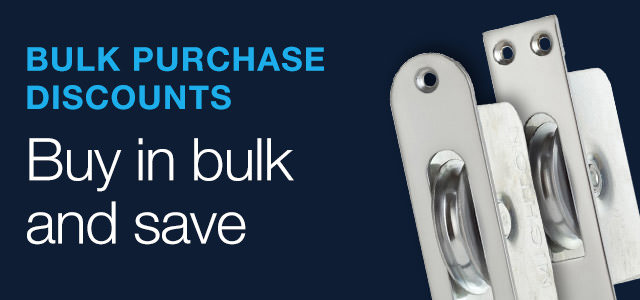Our calculator will help you calculate the sash weights you need for your window.
Our calculator will help you calculate the sash balances you need for your window.
Browse our full range of sash weights, balances, pulleys and hardware.
If you have a question regarding our products or how best to use them, take a look at our Frequently Asked Questions section.
Spiral Balances
Sash window balances (sometimes called sash balances, spring balances or window balancers) are used to counterbalance the weight of the sash in a sash (double or single hung) window. They assist you in opening and closing your windows by compensating for the weight of the sash.
Sash balances can be used to replace traditional weights and pulleys in existing sash windows or fitted as standard in new windows. The Spiral sash balance consists of either one (Standard Balances) or two (Easylift) springs inside a tube with a spiral rod running through the middle of the spring(s). The spring(s) inside the tube determine the weight range the unit will counterbalance and allow for tensioning of the balance. The spiral is used to control the travel of the balances as it extends and retracts.
If your sash (frame and glass) weighs 20lb for example, you will need a pair of balances from the correct range to counterbalance it. Balances are fitted to either side of the sash frame and then connected to the sash you wish to counterbalance. Some balances can operate within a weight range, for example 10lb-20lb. This means that you can use them for any weight in that range. You can tension them (adjust the spring tension) by using a sash balance key to fine-tune the tension and ensure counterbalancing is perfect.
Visit our Introduction to sash balances page for more information or have a look at our instructional video.
All of our sash balances come with detailed fitting instructions which will help you insert them into your sash window. For further information on how to install a sash balance, watch our useful video. If you would like to chat to us about installing your balance, please call on 01223 497097.
You must be careful not to ‘over-tension’ your balance and detailed instructions are always provided with our balances. Take a look at our handy video on balances.
Mighton Standard balances are single spring balances. They only have one spring inside them. The spring is wound up with a balance key to provide the correct amount of spring tension to counterbalance the weight of your sash.
Our superior Easylift™ range has two springs, one spring provides the counterbalance and the other is designed to make operating the sash smoother and operate with less effort. We recommend you fit Easylift™ wherever possible.
Sash Pulleys
The 1 ¾” or 2″ denotes the wheel diameter. We offer both sizes of pulleys from stock in a range of finishes. Please note that pulley selection is not solely based on the aesthetic look of the pulley. Pulleys are also rated by the load a pair of pulleys will bear. Selection is based firstly on choosing the correct pulley for the the glazed weight of the sash and only then on the available space on the pulley stile & aesthetic.
PVD or Physical Vapor Deposition is a process used to decorate and protect metals.
It’s a thin layer of a durable chemical and has the advantage of being harder and more corrosion-resistant than many coatings applied by the electroplating processes or for example lacquering. PVD has good impact strength, excellent abrasion resistance and is so durable that protective topcoats are almost never necessary.
In addition, PVD application is often more environmentally friendly than traditional coating processes such as electroplating and painting. We use PVD to provide a brighter, durable brass effect as an alternative to lacquered brass and offer a 20 year replacement guarantee on our PVD coated products. Subject to our T&C’s.
Sash chain tends to be used on heavy sashes where cord may stretch or snap. Our standard range of pulleys have been developed with a semi-circular groove in the wheel to accommodate sash cord. However, we do supply a small range of larger pulleys with a flat groove in the wheel especially for our sash chain.
Mighton Coatings Exterior Joinery Paint
End Grain Sealer is available in clear or white and is used to seal the open grain of timbers that are likely to be subject to moisture uptake. A good example would be the ends of a window cill. By applying the sealer prior to priming, you can dramatically increase the life of the joinery.
Some substrates will work perfectly well with a standard primer. However, our joinery customers tell us they prefer to use a product where they dont have to worry about the substrate’s absorbency. So, we chose to sell sealer primer instead. Sealer primer is an enhanced primer that generally offers better performance than traditional primers. It has better blocking characteristics and provides an even base coat or mid coat, sands smooth and accepts our range of water-based top coats beautifully. This is especially necessary where timber is subject to ‘Tannin bleed’ or ‘weep’. Our sealer primer will seal that for you and it is also excellent for priming Accoya and other modified timbers too.
Our range of exterior and interior topcoats are matched to our own recipes, but in our opinion are closest to RAL 9010 Pure White. Please note these are not an exact match.
Our range of paints are water-based modern paints designed to provide maximum overage and durability.
Whilst it is possible to put our paints over other systems, we don’t recommend doing it without firstly checking a small unobtrusive area as we cannot vouch for the product you already have on your joinery. In addition, our paint will only be as good as your base. So, we recommend returning the joinery to bare wood and priming and painting using our product where possible.
Angel Ventlock
European standards define ‘Safety Restrictors’ as follows:
The product has been tested to and passed the stringent international (ASTM F2090-2008, 2010 and 2017) and European (BS EN 14351-1:2006, BS EN 8213-1-2004, BS EN 14609:2004) Standards.
Whilst all of our angel products can be fitted by the homeowner, two (Facefix and Sidefix) require a rebate to be machined into the face of the sash stiles. Retrofit simply requires screwing into position. Rebate dimensions are shown in the downloadable fitting instructions on each product page.
Sash Weights
To work out what weights you’ll need for your window, you’ll need to start by weighing the sashes and measuring your sash window. Once you know the weight and have the dimensions, the easiest way is to use our Product Calculators which will help you to determine the weights you need. If you require any further help, please don’t hesitate to call us on 01223 497097.
Steel sash weights were developed by Mighton Products as a cost effective alternative to traditional lead weights. If you are upgrading your glazing, your sash weights are probably going to have to be changed to accommodate the extra weight of your sashes. You can make significant savings by changing to our steel sash weights. Calculate your requirement using our Product Calculators and see the difference. Note, please make sure your sash box can accommodate our steel weight sections before buying.
Lead make weights are slipped down the sash cord and usually sit on top of the sash weight. They are available in 1/2, 1 and 2lb increments and used to ‘calibrate’ your sash windows. By adding or subtracting small amounts of weight, you can make sure your sashes are perfectly balanced. This ensures opening and closing them is effortless. Deflector weights are Makeweights with a conical top. The top prevents the sash weights fouling on each other as they pass each other in the sash box. They are only required if the length of the weights would cause them to foul.
Timber Beading
Staff bead is a timber or WPC (Wood Plastic Composite) bead used to secure the sashes into the sash frame. It is fitted around the inside perimeter of most designs of box sash window. Nowadays, Staff bead often incorporate some form of weatherproofing product such as brushpile, Standard weatherstrip or a weatherseal such as Aquamac. Download our Guide to weatherproofing for more information and product selection.
Guide-to-Weatherproofing.pdf and check out our Anatomy of a sash window.
Parting bead is a timber or WPC (Wood Plastic Composite) bead used to separate the sashes into the sash frame. It is normally fitted up the pulley stiles and across the head of most designs of box sash window. Nowadays, Parting bead often incorporate some form of weatherproofing product such as brushpile, or a weatherseal such as Aquamac. Download our Guide to weatherproofing for more information and product selection.
Guide-to-Weatherproofing.pdf and check out our Anatomy of a sash window.
We are members of the the Forest Stewardship Council (FSC®). The FSC® is an international non-profit, multi-stakeholder organisation established in 1993 that promotes responsible management of the world’s forests. Look for the FSC® logo on our timber and Mightybead (Wood Plastic Composite) products.
Carrier is a plastic channel which is inserted into our timber beading to allow brushpile to be easily slid in. Heritage timber beading does not contain a carrier, the brushpile is inserted into a groove in the timber. Both work. Pre-inserted plastic carrier can save a lot of time on a job if you are replacing brushpile or removing it to paint. However, some heritage property owners prefer not to have modern plastics used in the manufacture of their sash windows and select our Heritage beading. The choice is yours.
Other FAQ
In order to improve your insulation, it’s necessary to add brush or pile to limit the draught. Mighton stock a range of weatherstripping, staff and parting beads which can help contain draughts and prevent heat from escaping.For more information, take a look at our Guide-to-Weatherproofing.pdf and check out our Anatomy of a sash window.
Alternatively call our helpful and knowledgeable Sales team for advice on 01223 497097
It’s easy to access your trade account online! If you’ve never done so before, you’ll need to create an online account which will allow you to easily track your orders. When you arrive at the checkout, simply select pay on Account and enter your PO number. It’s as easy as that. For more information on opening a Trade Account or accessing your account online, click here.
Samples can be requested for many of our products by clicking the sample request button on the page of the product you require. Alternatively, simply fill in our sample request form here (link required) and we will post them out to you. If you can’t find the product you require on the site, give us a call on 01223 497097 and we will be happy to locate what you are looking for and send out samples.
Publicly Available Specification (PAS) 24 is a standard that relates to the security performance of doors and window products that are intended for residential use.
In order to be certified to PAS 24, a product must pass a series of tests simulating attempted break-ins using a range of tools and techniques. These tests are designed to ensure that the product can withstand forced entry to an acceptable standard on a residential property.
By meeting the requirements of PAS 24, manufacturers can demonstrate to consumers that their products have been independently tested and certified as providing enhanced security.
Secured by Design (SBD) is a police-led initiative in the UK that aims to reduce crime through design. It is a national standard based on the principles of ‘designing out crime’ and all products have been developed in partnership with the police and other crime-prevention experts.
Products and services that meet the SBD standards have been tested and certified to provide a high level of security against criminal activity, making them suitable for residential use. Only approved manufacturers can produce SBD approved products


Our friendly support team is happy to help.
View our knowledge hub for calculators, installations, data sheets, videos & guides.
Download our catalogues or order a paper copy delivered to your door.
Manage your cash flow with 30 days free credit & flexible credit limits.

